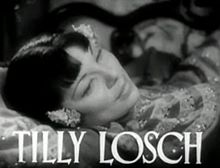Tilly Losch
Outside the Opera, Losch took modern dance class with Grete Wiesenthal and Mary Wigman, and performed dramatic and movement roles in Viennese theaters, at the Salzburg Festival and in Max Reinhardt's 1924 Berlin production of A Midsummer Night's Dream, also choreographing the William Shakespeare play.
Losch danced the leading role (a dual figure) and Lotte Lenya, with whom she had a love affair at that time,[2] sang it.
Losch was divorced by James in 1934, after being accused by him of adultery with Prince Serge Obolensky, a Russian-American hotel executive; her countersuit, in which she made it clear that her husband was homosexual, failed.
As Tilly emerged from the bath, leaving behind a trail of wet footprints as she ascended the spiral stairs, Edward subsequently commissioned the carpet with the motif woven into it as a token of his love for her.
Losch guested with Ballet Theatre in New York in a work by Antony Tudor and in London danced Léonide Massine choreography.
Prominent choreographers who made roles for Losch include Sir Frederick Ashton, Fred Astaire, George Balanchine, Heinrich Kroeller, Leonide Massine, and Antony Tudor.
Her earliest works were self-portraits, but she later created portraits of friends such as Anita Loos, Lotte Lenya, and Kurt Weill, and she received encouragement from Cecil Beaton.
Carnarvon, aware of Losch's delicate health, sent her to the United States, where he perceived she would be safe from the growing danger of the war in Europe.
She mounted her first exhibition in New York City in 1944, and was well received by critics; the prominent collector and museum founder Albert C. Barnes bought one of Losch's works from her Dutch debut show.

The Good Earth (1937).